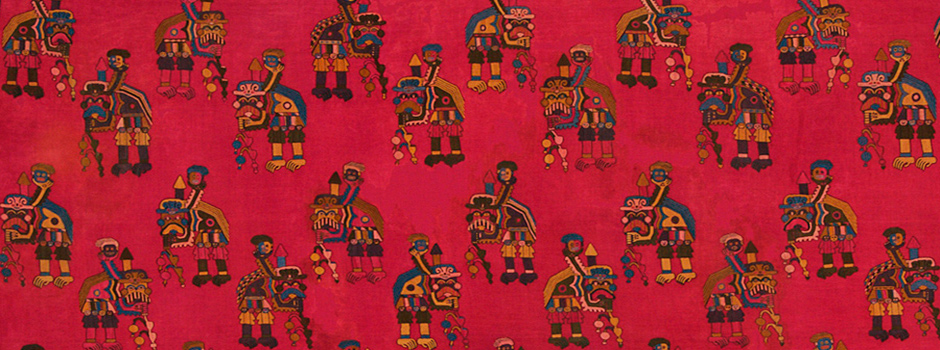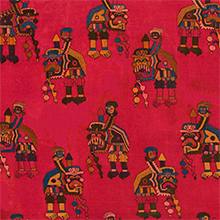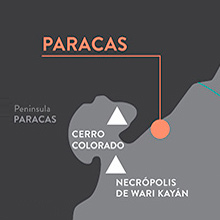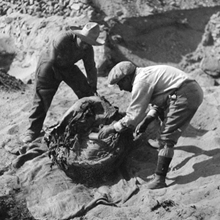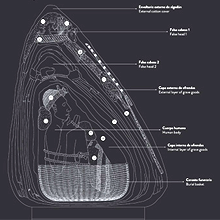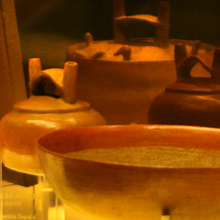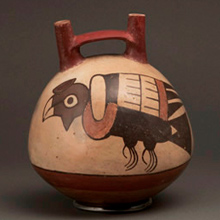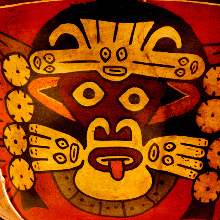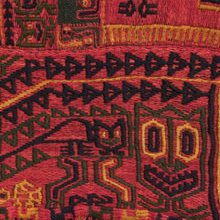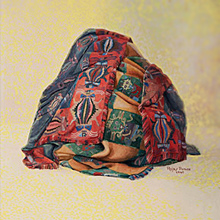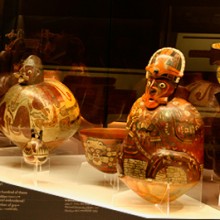Paracas Funerary Mantles: Offerings for Life – 2015
Presentation
Since being discovered by archaeologists nearly a century ago, the magnificent embroidered textiles of the Paracas culture have not ceased to amaze people around the world. They were crafted in the south of Peru around the beginning of the Common Era and lay buried under the sand for approximately two millennia. Today, we know that textiles had a special role in Paracas society that was quite different from their role in modern times. For close to 300 years, successive generations of these farming and fishing peoples used them as symbols of identity and distinction, as an important channel of communication with the gods and as indispensable offerings in the tombs of their ancestors or forebears. Beyond their unparalleled beauty, therefore, these textiles, the grave goods found with them, and the funerary bundles that contain them provide a vital source of information about the religious ideas and beliefs of that ancient society of the southern coast of Peru.
In the exhibition, Paracas Funerary Mantles: Offerings for Life, the Museo Chileno de Arte Precolombino is proud to present 52 archaeological objects belonging to the Ministerio de Cultura del Perú, Museo Nacional de Arqueología, Antropología e Historia del Perú (MNAAHP). Almost half of the pieces are from the Paracas Necrópolis period (100 BC-AD 200) and were discovered at Wari Kayán, a vast sandy cemetery that stands in front of the sea on the arid Paracas peninsula. The collection on display includes uncus (tunics), short ponchos, turbans, headbands, belts, skirts and other textile artifacts. It also comprises nine ceramic vessels from the early period of the neighboring Nasca and Early Nasca society (AD 1-200), three ceramic vessels in the Topará style, 10 metal ornaments, two rods used as tomb markers, a fan, a seashell bead necklace, a mace, a knife, a bone flute and eight miniature textile items, among other grave goods. However, there is no doubt that the most stunning items in the exhibition are the eight enormous funerary mantles, all of them richly decorated.
The exhibition begins by informing visitors about the society that produced the objects, the environment in which its people lived, their subsistence strategies, principal crafts, and their relative position within the complex cultural history of ancient Peru. Following this is a brief summary of the Wari Kayán cemetery and the person who discovered it—Peruvian archaeologist Julio César Tello. Visitors will next find out what a funerary bundle looks like and what it consists of, and then will discover how investigators “read” the images captured on both the ceramic vessels of the neighboring Early Nasca society and the textiles found in the funerary bundles of the Paracas Necrópolis period. In the following section, museum visitors will learn the main features that have made textile art from this period renowned around the world, learning, too, along the way, how a chief or elite member of that society dressed. The dark, narrow passageway that visitors must walk through in this exhibition—with ghostly wall projections of different textile layers from a funerary bundle—provides the perfect metaphor for visitors to go into the next room. There they will enter the world of the dead and learn that, in the ideas and beliefs of Paracas society, and indeed across the Andes, dying always signified a return to life. Under the half-light of the gallery, eight stunning, intricately decorated sacred mantles “hang” in the air, embroidered with a wide variety of figures that have been interpreted variously as ancestors or shamans who are intended to accompany the deceased into that ‘life after life’.
The texts in this catalogue are based primarily on the catalogues, Paracas, trésors inédits du Pérou ancien and Mantos para la eternidad: Textiles Paracas del antiguo Perú, published respectively by the Musée du quai Branly and the Museo de América for the exhibitions that these same two institutions held with this collection in Paris and Madrid in 2008 and 2009. The texts in this catalogue follow the general order of items displayed in the galleries, although they are more extensive and detailed than those in the exhibition itself. We sincerely hope that our visitors enjoy this exhibition as much as we have enjoyed assembling it for you.
MUSEO CHILENO DE ARTE PRECOLOMBINO




































